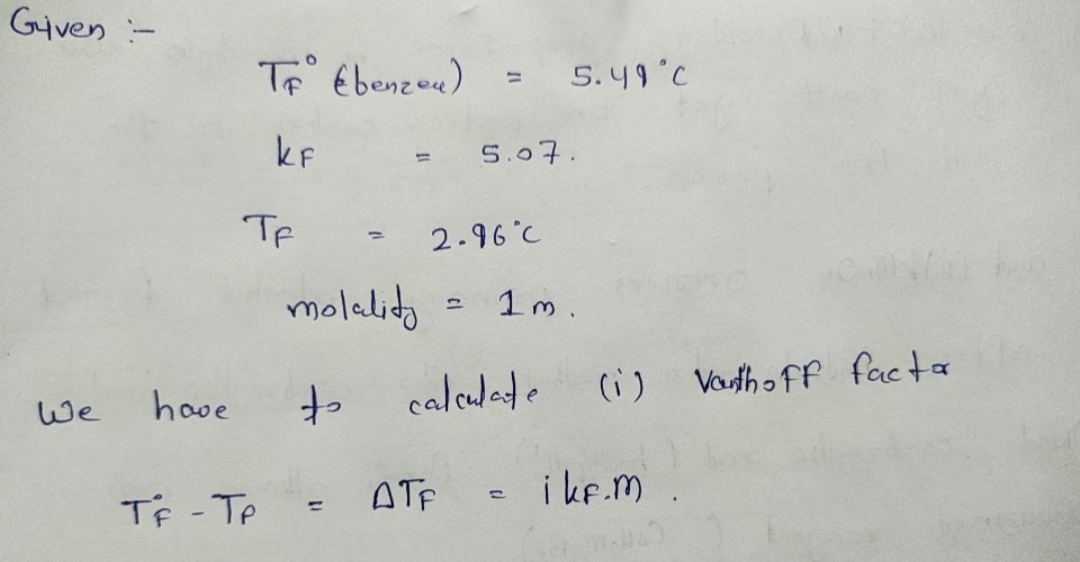A 1.00-m solution of acetic acid, CH3COOH, in benzene has a freezing point of 2.96°C. Use the data in the Table to calculate the value of i and suggest an explanation for the unusual result. (Hint: If i is less than 1.0, each formula unit that dissolves yields less than one solute particle, an outcome suggesting aggregation of solute particles.)
A 1.00-m solution of acetic acid, CH3COOH, in benzene has a freezing point of 2.96°C. Use the data in the Table to calculate the value of i and suggest an explanation for the unusual result. (Hint: If i is less than 1.0, each formula unit that dissolves yields less than one solute particle, an outcome suggesting aggregation of solute particles.)
Chemistry
10th Edition
ISBN:9781305957404
Author:Steven S. Zumdahl, Susan A. Zumdahl, Donald J. DeCoste
Publisher:Steven S. Zumdahl, Susan A. Zumdahl, Donald J. DeCoste
Chapter1: Chemical Foundations
Section: Chapter Questions
Problem 1RQ: Define and explain the differences between the following terms. a. law and theory b. theory and...
Related questions
Question
A 1.00-m solution of acetic acid, CH3COOH, in benzene has a freezing point of 2.96°C. Use the data in the Table to calculate the value of i and suggest an explanation for the unusual result. (Hint: If i is less than 1.0, each formula unit that dissolves yields less than one solute particle, an outcome suggesting aggregation of solute particles.)
Answer is:
i = 0.50; formation of dimers of composition (CH3COOH)2, need steps shown to understand though

Transcribed Image Text:TABLE 16.2 Boiling point elevation constants (K,) and freezing point depression constants (K;) for various solvents
Solvent
Boiling point/°C
K,/K-m̟'
Freezing point/°C
K;/K-m̟'
benzene
80.09
2.64
5.49
5.07
camphor
(207.4)*
5.95
176
37.8
cyclohexane
80.73
2.92
6.59
20.8
ethanoic acid (acetic acid)
117.9
3.22
16.64
3.63
nitrobenzene
210.8
5.2
5.7
6.87
trichloromethane
61.17
3.80
-63.41
4.68
water
100.00
0.513
0.00
1.86
Expert Solution
Step 1

Trending now
This is a popular solution!
Step by step
Solved in 2 steps with 2 images

Knowledge Booster
Learn more about
Need a deep-dive on the concept behind this application? Look no further. Learn more about this topic, chemistry and related others by exploring similar questions and additional content below.Recommended textbooks for you

Chemistry
Chemistry
ISBN:
9781305957404
Author:
Steven S. Zumdahl, Susan A. Zumdahl, Donald J. DeCoste
Publisher:
Cengage Learning

Chemistry
Chemistry
ISBN:
9781259911156
Author:
Raymond Chang Dr., Jason Overby Professor
Publisher:
McGraw-Hill Education

Principles of Instrumental Analysis
Chemistry
ISBN:
9781305577213
Author:
Douglas A. Skoog, F. James Holler, Stanley R. Crouch
Publisher:
Cengage Learning

Chemistry
Chemistry
ISBN:
9781305957404
Author:
Steven S. Zumdahl, Susan A. Zumdahl, Donald J. DeCoste
Publisher:
Cengage Learning

Chemistry
Chemistry
ISBN:
9781259911156
Author:
Raymond Chang Dr., Jason Overby Professor
Publisher:
McGraw-Hill Education

Principles of Instrumental Analysis
Chemistry
ISBN:
9781305577213
Author:
Douglas A. Skoog, F. James Holler, Stanley R. Crouch
Publisher:
Cengage Learning

Organic Chemistry
Chemistry
ISBN:
9780078021558
Author:
Janice Gorzynski Smith Dr.
Publisher:
McGraw-Hill Education

Chemistry: Principles and Reactions
Chemistry
ISBN:
9781305079373
Author:
William L. Masterton, Cecile N. Hurley
Publisher:
Cengage Learning

Elementary Principles of Chemical Processes, Bind…
Chemistry
ISBN:
9781118431221
Author:
Richard M. Felder, Ronald W. Rousseau, Lisa G. Bullard
Publisher:
WILEY